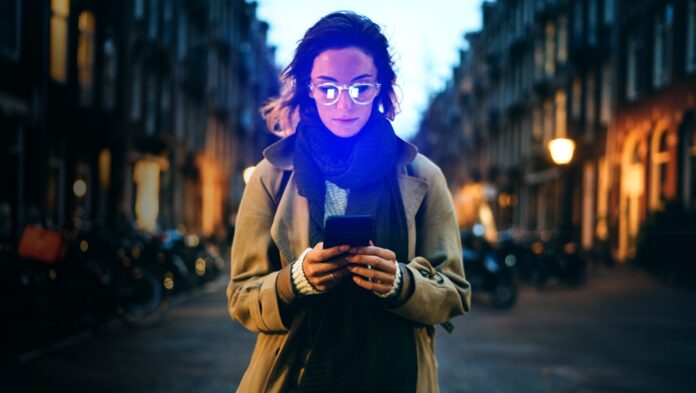Research suggests the blue light emitted from our phones and screens is damaging the health of our skin and accelerating ageing.
In recent years, our beloved digital devices have been credited with limiting our attention spans, raising our anxiety levels and, perhaps worst of all, ruining our beauty sleep. But since this hasn’t been enough to send us into a prolonged state of digital detox, experts are now suggesting our hand-held BFFs are playing havoc with our skin.
High Energy Visible Light (HEV) is the official name for the blue glare that comes from phones, laptops and tablets. Until now, researchers have primarily been concerned with the way blue light impacts the eyes; but interest is growing in how HEV may be affecting the skin, with emerging data indicating that prolonged exposure to blue light can accelerate the visible ageing process.
HEV Light makes up the blue portion of visible light in the electromagnetic spectrum and is a natural part of sunlight. Unlike UVA and UVB light, blue light is not linked to skin cancer, but it does share UV’s potential for accelerating free radical damage. When exposed to free radicals, the proteins which support the skin’s strength and elasticity, collagen and elastin, grow weak, which in turn gives fine lines and wrinkles a chance to take hold. Continuous exposure to HEV Light also impairs the skin’s protective barrier function, a situation that can result in inflammation and hyperpigmentation.
What can be done?
Since blue light penetrates deep into the skin, sunscreen will not keep it from damaging the complexion. With this in mind, a slew of brands like Charlotte Tilbury, Murad, Ilia, Coola and BareMinerals have become focused on developing products that include HEV Light protection. The secret to existing blue light resistant products is their antioxidant ingredients, which help shield the complexion from environmental nasties and limit the extent to which blue light can penetrate the skin.
Blue light filters are also available for phone and laptop screens. Switching your devices to night mode can limit their blue light emissions by counteracting HEV Light with a yellow filter.
Keeping your phone away from you face by using headphones when chatting is a simple way to minimise blue light exposure. Or, of course, ditching your device altogether and creating a bit of digital distance could do the trick.
Become body aware
Unfortunately, blue light isn’t the only issue at play when it comes to screen-related skin ageing. While postural problems and shoulder pain are among tech neck’s most frequently discussed symptoms, constantly looking down at your screen also creates the perfect environment for neck wrinkle formation.
As New York dermatologist Dr Jeanette Graf told Elle: ‘The horizontal creases on the neck have a lot to do with positioning. The more movement, the more you’re going to reinforce the way those lines are falling. If you’re going to always be on your phone, it’s best to bring it eye level, rather than looking downward.’
Stress is another factor that can be linked to both phone use and skin health. According to the American Psychological Association’s 2017 Stress in America survey, almost 20 per cent of Americans cite the use of technology as a ‘very or somewhat significant source of stress’. Just as constantly furrowing your brow can create future lines, ‘smartphone scowl’ could lead to facial tension and premature ageing.
INTEREST IS GROWING IN HOW HIGH ENERGY VISIBLE LIGHT (HEV) MAY BE AFFECTING THE SKIN, WITH EMERGING DATA INDICATING THAT PROLONGED EXPOSURE TO BLUE LIGHT CAN ACCELERATE THE VISIBLE AGEING PROCESS.
References:
Blue light study: ncbi.nlm.nih.gov/pmc/articles/PMC4337113/
Elle: elle.com/beauty/news/a43443/neck-wrinkles-phoneposture/
Stress in America: apa.org/news/press/releases/stress/2017/technology-social-media.PDF
Cosmopolitan: cosmopolitan.com/style-beauty/beauty/how-to/a11048/is-your-smartphonecausing-acne/
Acne: allure.com/story/phone-ruining-skin
Contact Dermatitis: liebertpub.com/publications/pediatric-allergyimmunology-and-pulmonology/48
More than just fine lines
Unfortunately, our hand-held friends can mess with our complexions in more ways than one. If you suffer from breakouts or contact dermatitis, your phone could be to blame.
ACNE
Our phones have become our technological shadows, joining us everywhere we go. This includes some less than hygienic places like the bus and the bathroom, which means our devices are often covered in germs. Bacteria is one of the main causes of acne.
As New York-based dermatologist Debra Jaliman told Cosmopolitan, ‘when you hold your phone up to your face…there is a mechanical stimulation (the pressure against the oil glands) that triggers them to produce more oil…Then, the bacteria from the screen – and the heat that it gives off that breeds more bacteria – mixes together and results in a blemish.’
CONTACT DERMATITIS
Believe it or not, it is possible to be allergic to your phone. According to a study published in the Pediatric Allergy, Immunology, and Pulmonology Journal, using a phone for 30 minutes or more every day can increase the risk of allergic contact dermatitis (ACD) for those with nickel, cobalt and chromium allergies. Because chromium and nickel are found in phone cases, covering your mobile and its screen with a plastic case and screen protector can prevent the itchy rash that accompanies ACD from forming.









